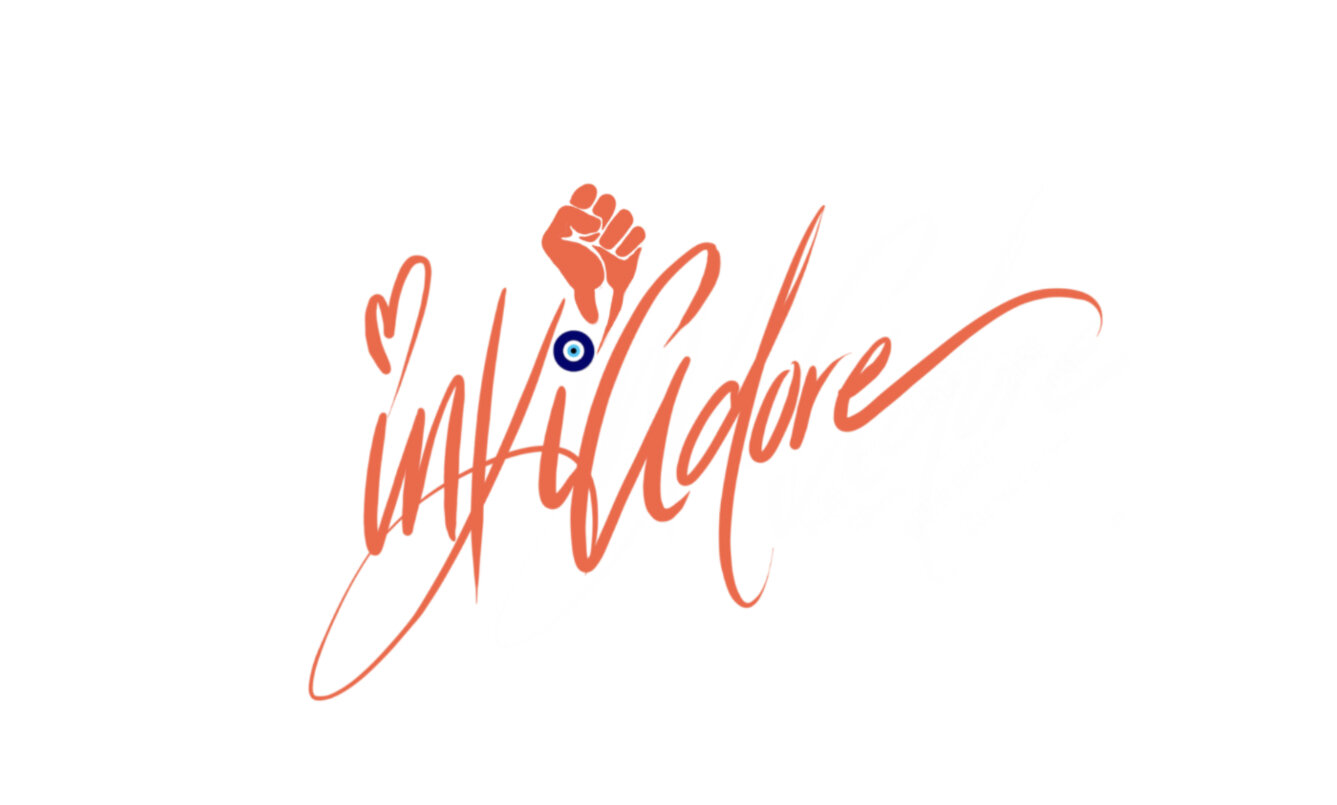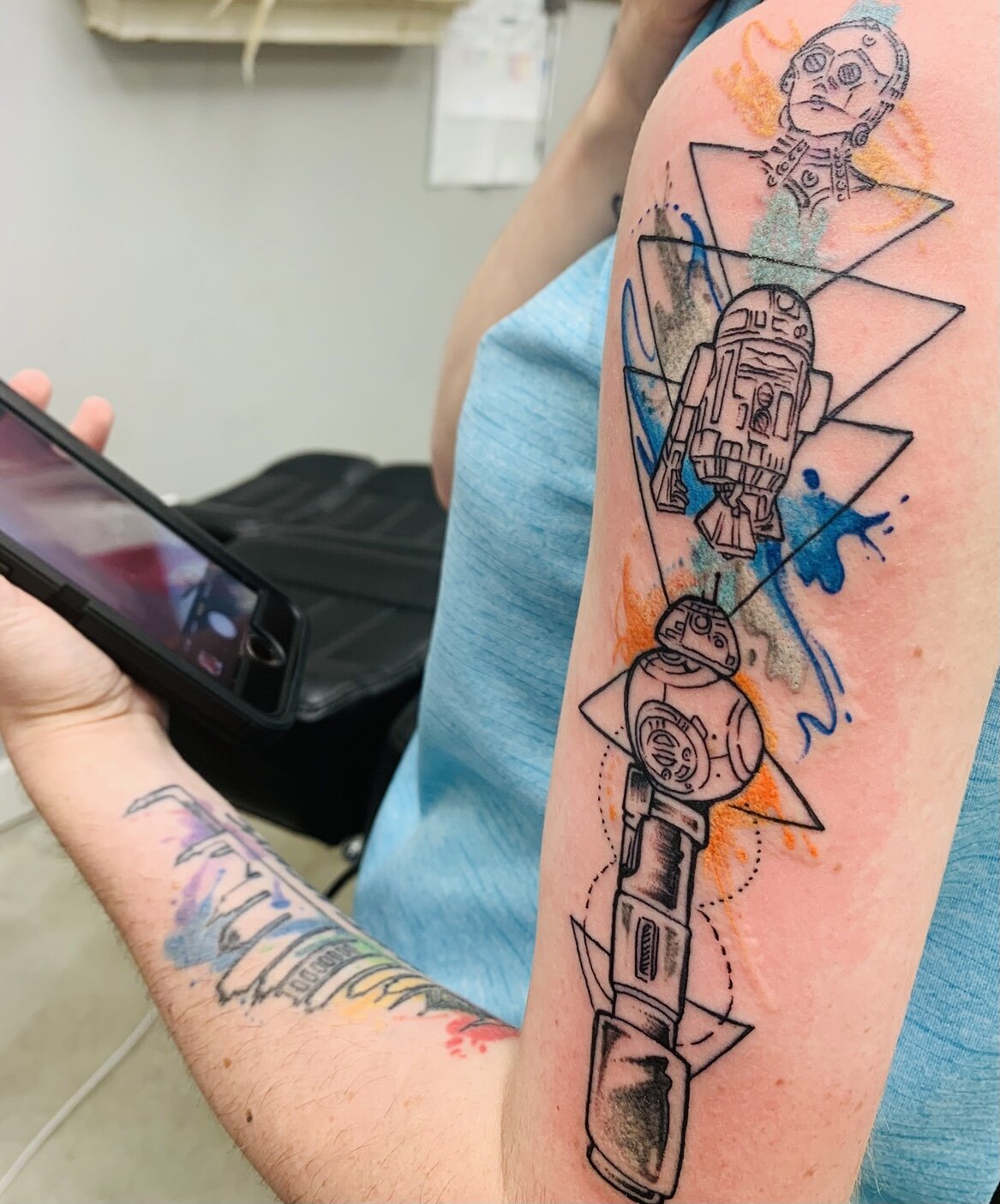
Tattoo
Before & Aftercare
with FAQ
-
Before
Here is how your interaction with your artist and getting your tattoo done will likely unfold:
Reach out to the shop by either walking in, texting to setting up a consultation online.
Meet the artist to talk about your design and expectations.
Once the sketch is finished (this will be sent to you), agree upon the final design. If revisions are needed, let the artist know so they may make any changes before your appointment date.
Aspirin, ibuprofen and the consumption of alcohol should be off limits within the 24 hours leading up to your appointment, as they can thin your blood.
Plan to wear something that will keep the area being tattooed exposed and you don’t mind getting stained by the ink, as will as, something you can easily slip in and out of.
Show up to your appointment on time so the artist has enough time to finish within your scheduled appointment.
Fill out any paperwork and, if needed, finalize any details of your design.
Your artist will take you to their station. You may need to roll up or remove any clothing that may be in the way of your tattoo placement.
Your artist will disinfect the area and use a disposable razor to remove any hair.
Your artist will then place the tattoo stencil onto your skin. Move this around as much as you like until you’re happy with the placement!
Once the placement is perfect, your artist will being tattooing. Outlines are usually done first before filling in any colors or gradients. However, depending on style some tattoos do not require an outline.
After your artist is finished, they’ll clean the tattooed area, wrap it up, and tell you how to take care of it.
WHAT TO EXPECT?
Yes, it’s going to hurt.
How much it hurts depends on your pain tolerance, size, and location. Tattoos tend to hurt more around sensitive areas that have more nerves and less flesh.
You may feel:
Scratching. This is more common with tattoos that require shading.
Sharp stinging. Although this is usually associated with detailing, it may also happen with tattoos on areas with tighter skin, like your wrist.
Burning. This is the most common feeling, and it’s caused by the needle going over the same spot multiple times. Take a deep breath! It’ll be over before you know it.
Vibrating. This is more common with tattoos in bonier areas, like your ribs or on your foot.
Dullness. All feelings will eventually melt into a dull roar. Once you reach this point, you’re home free.
Whatever it is that you may feel, I promise you can get through it and have beauty piece you can cherish forever.
-
After
How to take care of your tattoo
Here at Inkiadore, we use a second skin to cover your new tattoo. If you are allergic to any type of adhesive, we will simply wrap you tattoo with other bandage that will not irritate you.
This section explains how to take care of your new tattoo with both this technique and with regular covering.
Second skin or, as some can refer to as Tegaderm, is a medical-grade, transparent, adhesive barrier that protects new tattoos while they are healing.
latex-free,
waterproof
breathable
hypoallergenic
The first week is a crucial time when it comes to healing tattoos. Because it's breathable and waterproof it can be left on during that period. It will protect the tattoo from bacteria and debris, while also helping to save clothes and linens from ink and blood.
Keep the regular dressing on for at least 2-3 hours, We suggest keeping the second skin on for at lest 24 hours to 3-4 day if you can, especially if you planning to spending the rest of the day out and about to keep dirt and bacteria from entering your fresh tattoo. Not doing so can damage it or slow the healing process, remember a new tattoo is and open wound.
When it’s time to take the dressing off, be sure to wash your hands before you removal. Taking Second skin off in the shower with soap and water is the best method.
After you take the dressing off, wash the tattoo with a gentle, unscented soap. You should avoid using any soap with fragrances or alcohol, as these ingredients can cause irritation.
Then gently pat the area dry with a clean towel. Do NOT rub!
Rubbing can pull at the skin and may cause ink fallout.
If you’re dealing with itchy, dry skin, apply a thin layer of your Aquaphor ointment or unscented lotion.
If the tattoo starts to flake or peel, don’t panic. This is a normal part of the healing process, and it usually only lasts through the end of the first week. Just don’t pick at it, this can lead to ink fallout and ruin your art.
DO NOT
Scratch, peel, pick, rub your tattoo
Let your tattooed skin dry out
Soak in a hot tub or go swimming
Expose your tattoo to the sun for the first 2-3 weeks
Wear tight clothing over your new tattoo, like bra straps or waistbands
Shave on or near your new tattoo
We will give you a verbal rundown of how to take care of your new ink and send you home with a handout to reference later. You should always follow your artist’s aftercare instructions.
How to maintain your tattoo
Most tattoos heal at the surface layer within the first couple of weeks, but it may be months before it’s healed completely. Not keeping up on care can delay the healing process and also affect how your tattoo looks in the long term.
Practicing good hygiene is the only way to reduce your risk for infection.
In addition to keeping the tattoo clean, you want to keep it fresh and hydrated. Exposing the tattoo to direct sunlight can cause the colors to fade, so invest in a quality sunscreen or SPF clothing. Dry skin can also cause a tattoo or the ink to look dull.
-
FAQ
Are Tattoos Safe?
YES, please make sure you go to a reputable artist that is licensed and follows all recommended safety precautions. Also, make sure you're fully honest about any medical conditions.
Does It Hurt?
We would be lying if we said NO, but keep in mind that everyone has a different tolerance for pain and some areas hurt more than other.
You might feel:
stinging
scratching
burning
vibrating
dullness
Think about this, we wouldn’t have returning customers if it was that bad.
When should I NOT get tattooed?
Drunk
High
Pregnant
Pre-Surgery
Post-Surgery
When you don’t know what you want
When you can’t afford it
When you’re sunburned
Being pressured into it
How Much Is It Going to Cost?
When it comes to tattoos, you get what you pay for. Look for quality, and be willing to pay for it. Never haggle over the price of a tattoo. It is disrespectful to the artist.
Here at Inkiadore we base price on size and detail.
This is a piece of art you'll wear for life and maybe even after
Should I Tip My Tattoo Artist?
Tipping is a really nice gesture. But, there are no real solid ground rules for tipping.
What Should I Get? And Where?
This is all a matter of personal taste. You can get whatever you want, and whatever your artist is willing to do. Your only limit is your own imagination. As far as where you should get it goes, just keep in mind what you do for work and the type of social circles you are in. You might want to consider placing your tattoo where it can be easily covered up with normal clothing.
What Is the Best Time of Year to Get a Tattoo?
Although you can get a tattoo any time of the year, your skin gets a lot more abuse during the summer with swimming, tanning, and just being exposed to the elements more. Winter time is really the best season to get a tattoo.
Can I get Tattooed if I'm Sick?
Getting a tattoo when your immune system isn't at 100% isn't a good idea. You're going to need your strength and your white blood cells to heal your tattoo, something your body won't be able to do if it's already doing battle against virus and bacteria. Not to mention the fact that it's very inconsiderate to bring your illness into the tattoo studio and risk passing the germs onto others, particularly your artist. If you have an appointment, call and reschedule for when you're feeling well again.
Where Can I Find Pictures of Tattoos?
If you're getting a tattoo, especially as an expression of your individuality, why would you want a tattoo just like someone else's? Instead, find other pictures of what you're looking for and have your artist draw up a custom design for you. Example: If you are wanting a tattoo of a penguin standing on a glacier, find real photos of penguins and glaciers. If you want a tattoo of a blue rose wrapped around a cross, find pictures of real roses and crosses that you like. If the pictures don't show exactly what you want, just take them to your artist to use them as guidelines and tell them what changes you want to be made to the original pictures. A real artist will welcome the challenge of a custom piece.
Ways to discuss your Tattoo
Below are a couple different ways you can get in contact with us to share your tattoo ideas.
If you still need help please feel free to contact us or see our consultation section to read more about it.
Text
If you already know what you want or you can’t make it in to talk to an artist, you can always text us at (202) 422-0100:
Name
Design (a description or reference pictures.)
Style (what type of tattoo style)
Location (approx. placement)
Size (est. of how big)
Dates (when you are available)
Color or black and gray
Book Consultation Appt. or Simply Walk-in
The button below will lead you to our online booking in which you can schedule your consultation appointment. We do NOT book actual tattoo appointments online.
or
You can just stop by and walk-in to come speak with someone about your tattoo.


